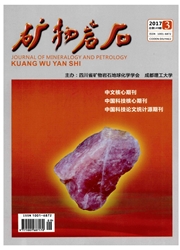

 中文摘要:
中文摘要:
大别山含霓辉碱性花岗片麻岩主要表现为超高压榴辉岩相变质之后的退变质组合,具有特征的浅色体、暗色体两部分,在浅色体中含有磁铁矿自形晶。而且,随着后期变形一变质改造程度的增大,可以形成碱长片麻岩、甚至石榴云母片岩,这种变化同时表现在矿物组合和多种矿物的成分方面:霓辉石趋于消失、斜长石An牌号逐步升高、云母和磷灰石的成分逐渐调整。榴辉岩相花岗片麻岩的退变至少可划分出两个阶段:早期“干”退变形成霓辉石和随后磁铁矿的产出,磁铁矿的形成与相对弱应变体系中特殊的流体成分造成的退变改造有关,随着变形强度的增大和以水为主的流体挥发分的介入,逐步形成普通的云母片岩。
 英文摘要:
英文摘要:
The aegirine-bearing alkaline granitic gneiss from the Dabieshan Mountains is domina- ted by retrograded mineral assemblages after the ultrahigh pressure eclogite facies metamorphism. The gneiss is characterized by the special melanosome and leucosome in which the euhedral magnetite crystals occur. With increasing degree of superposition of deformation-metamorphism, the gneiss was transformed into alkaline granitic gneiss and garnet-mica schist. The transformation was accompanied by change of minerals associations and mineral compositions, such as the disappearance of aegirine, the increasing An number of plagioclase, and the adjusting compositions of mica and apatite. At least two retrogressive metamorphic substages can be discerned in the felsic gneiss of eclogite facies,the early substage of aegirine and the late substage of magnetite for mation. The occurrence of magnetite in the aegirine-bearing granitic gneiss is related to the special fluid/volatile components in low strain domain. With enhancing deformation and involvement of the H2O-predominant fluids,the gneiss was transformed into general mica schist.
 同期刊论文项目
同期刊论文项目
 同项目期刊论文
同项目期刊论文
 期刊信息
期刊信息
